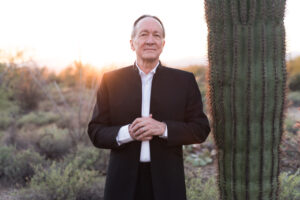4 Experts talk about the Heart
I believe that by rooting in both our physical and metaphysical hearts, humanity can operate from the core of love, compassion, and kindness. And so, for the past three decades, I have dedicated my life to helping our society manifest a heart-centered culture. As I have traveled the world, offering my own vision of heart-centered living, I have had the honor of meeting extraordinary individuals who walk this path with me. It is always enlightening to learn about the many unique ways of perceiving and working with the heart. I am pleased to share with you the wisdom of four diverse heart experts, offering their perspectives on the mechanics, energy, and health of the human heart.
The anatomical heart has four chambers — left and right ventricles, as well as left and right atriums. But the heart, experts agree, is far more than just a physical organ. Brian Luke Seaward, Ph.D. — executive director of the Paramount Wellness Institute in Boulder, Colo. and author of top-selling college textbook Managing Stress — describes the metaphysical heart, or symbolic heart, which resides over the center of the upper chest:
“Some people refer to the metaphysical heart as the heart chakra — an ancient Sanskrit word for ‘spinning wheel,’” Seaward notes. “Eastern tradition symbolizes the heart chakra as a lotus flower or water lily. This wisdom suggests that when this flower is open, energy flows freely from the symbolic heart to the anatomical heart. If the flower is closed, the vital energies necessary for proper heart function are compromised.”
Anger and fear, Seaward notes, close the heart chakra, whereas love and compassion open it. For this reason, he says, “love is essential for a healthy anatomical heart function, but you surely don’t read this in the medical literature. Sages and wisdom keepers called a closed heart chakra a hardened heart. That sounds a lot like atherosclerosis to me. You don’t need to look too far to see that the symbolic heart and the anatomical heart have much in common.”
Rollin McCraty, Ph.D., executive vice president and director of research at the Institute of HeartMath, agrees that there is an inextricable link between the physical and energetic hearts. Through years of research, his organization has discovered that emotional experience in fact can be measured by the pattern of heart activity. It is no surprise, McCraty says, that emotional states have a direct impact on heart health.
“There is overwhelming evidence that stress, sourcing from a wide array of emotional and social factors, significantly affects virtually all stages of the disease process — genesis, progression, and recovery,” McCraty says. He cites two studies by way of example, both published in the Journal of the American Medical Association. One documents a link between stress and an increased risk for heart attacks, depression, and cancer, and the other indicates that workplace stress may be as bad for the heart as smoking and high cholesterol.
The key, McCraty emphasizes, is understanding what exactly comprises stress.
“In essence, stress can be thought of as emotional unease,” he says. “The feelings of anxiety, irritation, impatience, frustration, lack of control, or hopelessness, are truly what we are experiencing when we describe ourselves as ‘stressed.’ While mental processes clearly play a role in stress, it is well-recognized that emotions, more so than thoughts, activate and drive the stress-related changes we experience in our body.”
Negative emotions, like anger and frustration, can inhibit mental functions and deplete energy, McCraty says, whereas positive emotions, like gratitude and joy, activate physical functions, renew energy, and optimize the body’s natural regenerative processes. To optimize heart health, McCraty concludes, one needs to replace negative emotions with positive ones — in other words, to master the emotional and energetic heart, in service to the physical heart.
In its online article series on stress management, The American Heart Association (AHA) verifies that stress-related feelings include anger, depression, and anxiety, and it confirms that stress launches a chain reaction of events leading to numerous physical ailments — such as pain, insomnia, and fatigue. While Donna K. Arnett, Ph.D., MSPH, the president of the AHA, agrees that acute stress itself can increase the risk of heart attack, however, she states that chronic stress is probably mediating more direct risk factors — such as smoking, poor diet, and physical inactivity — by increasing inflammation and blood pressure, and therefore by activating the sympathetic nervous system.
The AHA offers numerous tips for optimizing heart health, ranging from physical exercise and healthy cooking to daily relaxation and positive self-talk. “Remember to laugh!” advises the web banner atop the stress management articles. It is important, Arnett advises, to make changes slowly and to build a support system that will help sustain the changes. “A plan is really critical,” she emphasizes. “The person needs to have specific, measurable, and — importantly — realistic goals, not only to make the initial behavior change, but also to maintain the changes long-term.
Making small changes and seeing the success, Arnett explains, keeps people motivated to continue making changes. Regarding the issue of physical inactivity, for example, Arnett addresses the typical inert individual — the “couch potato.” By implementing a walking plan, she suggests, this individual can see incremental changes in speed and distance, which in turn can further motivate him to walk farther and faster. Instead of thinking about a behavior change as a temporary solution, Arnett continues, “think about making small changes that are sustainable, and then build on those changes towards better health every day.”
In addition to the heart health tips outlined on the AHA website, Seaward further advises cultivating a sense of gratitude, actively expressing and receiving love, behaving with kindness and compassion, and regularly practicing forgiveness, so as to “open the portals of the heart.” Activating the energetic heart, agrees McCraty, is key to optimizing heart health by neutralizing the discord of negative thinking. “The mind alone doesn’t have the power to shift emotional stress or change negative attitudes,” he says.
Throughout human history, McCraty continues, diverse cultural, religious, and spiritual traditions have regarded the heart “as an access point to the wisdom of our soul or higher source, from which love, wisdom, and intuition emanate.” New research, he says, is indicating that “this intuitive heart intelligence can elevate our communications, decisions and choices to a much higher level of effectiveness.”
This research marks growing interest in the role of the heart as a self-regulating mechanism. Still, despite the possibility that the heart may be the most powerful source of human intelligence, the number of studies on the heart are dwarfed by the amount of research on the brain. According to Jim Oschmann, Ph.D. — award-winning author of Energy Medicine: The Scientific Basis and founder of Nature’s Own Research Association— the discrepancy is simply a matter of technology:
“The brain reveals its activities in an elaborate pattern of electrical and magnetic fields that can be readily measured,” he explains. “Studies have shown that these patterns definitely change during meditation and during shamanic healings, for example. In contrast, the study of energy cardiology is its infancy. Cardiology does not yet have an understanding of the nuances of the heart’s field that compares with the details revealed by electroencephalography and magnetoencephalography.”
These nuances, Oschmann is confident, will be discerned as the field advances in neurocardiology — the study of neuronal activity in the heart.
Over the years, research on the brain has clarified how the mind affects the body and vice versa, which in turn has led to an explosion in the field of mind-body medicine. Once on the margins, meditation, yoga, and cognitive behavioral therapy are now mainstream. It therefore seems reasonable to expect that as research clarifies how the physical and metaphysical hearts impact each other, we will move towards a more heart-centered world — prescribing love, harmony, and beauty as some of the best medicine for a healthy heart.




